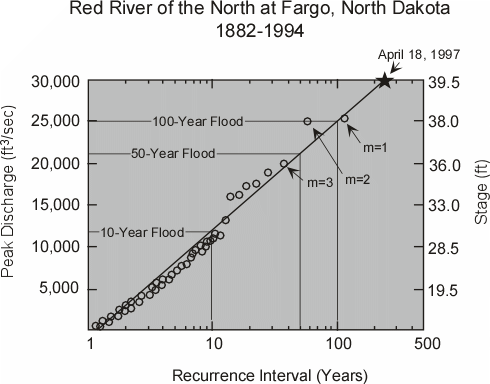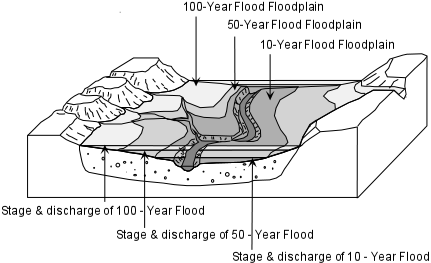♠ Posted by amsran in Flooding Hazards,Prediction & Human Intervention at 10:39 PTG
FLOOD
Hazards Associated with Flooding
Hazards associated with flooding can be divided into primary hazards that occur due to contact with water, secondary effects that occur because of the flooding, such as disruption of services, health impacts such as famine and disease, and tertiary effects such as changes in the position of river channels. Throughout the last century flooding has been one of the most costly disasters in terms of both property damage and human casualties. Major floods in China, for example, killed about 2 million people in 1887, nearly 4 million in 1931, and about 1 million in 1938 The 1993 flood on the upper Mississippi River and Midwest killed only 47 people, but the U.S. Army Corps of Engineers estimates the total economic loss at between 15 and 20 billion dollars (Click HERE for U.S. Army Corps' web site).
Primary Effects
Again, the primary effects of floods are those due to direct contact with the flood waters. As seen in the video last lecture, water velocities tend to be high in floods. As discharge increases velocity increases.
Again, the primary effects of floods are those due to direct contact with the flood waters. As seen in the video last lecture, water velocities tend to be high in floods. As discharge increases velocity increases.
- With higher velocities, streams are able to transport larger particles as suspended load. Such large particles include not only rocks and sediment, but, during a flood, could include such large objects as automobiles, houses and bridges.
- Massive amounts of erosion can be accomplished by flood waters. Such erosion can undermine bridge structures, levees, and buildings causing their collapse.
- Water entering human built structures cause water damage. Even with minor flooding of homes, furniture is ruined, floors and walls are damaged, and anything that comes in contact with the water is likely to be damaged or lost. Flooding of automobiles usually results in damage that cannot easily be repaired.
- The high velocity of flood waters allows the water to carry more sediment as suspended load. When the flood waters retreat, velocity is generally much lower and sediment is deposited. After retreat of the floodwaters everything is usually covered with a thick layer of stream deposited mud, including the interior of buildings.
- Flooding of farmland usually results in crop loss. Livestock, pets, and other animals are often carried away and drown.
- Humans that get caught in the high velocity flood waters are often drowned by the water.
- Floodwaters can concentrate garbage, debris, and toxic pollutants that can cause the secondary effects of health hazards.
Secondary and Tertiary Effects
Remember that secondary effects are those that occur because of the primary effects and tertiary effects are the long term changes that take place. Among the secondary effects of a flood are:
Predicting River Flooding
Floods can be such devastating disasters that anyone can be affected at almost anytime. As we have seen, when water falls on the surface of the Earth, it has to go somewhere. In order to reduce the risk due to floods, three main approaches are taken to flood prediction. Statistical studies can be undertaken to attempt to determine the probability and frequency of high discharges of streams that cause flooding. Floods can be modeled and maps can be made to determine the extent of possible flooding when it occurs in the future. And, since the main causes of flooding are abnormal amounts of rainfall and sudden thawing of snow or ice, storms and snow levels can be monitored to provide short-term flood prediction.
|
Frequency of Flooding
In your homework exercise you will see how flood frequencies can be determined for any given stream if data is available for discharge of the stream over an extended period of time. Such data allows statistical analysis to determine how often a given discharge or stage of a river is expected. From this analysis a recurrence interval can be determined and a probability calculated for the likelihood of a given discharge in the stream for any year. The data needed to perform this analysis are the yearly maximum discharge of a stream from one gaging station over a long enough period of time.
R = (n+1)/m
|

|
|
Pe = m/(n+1)
|
| Flood Hazard Mapping | |
| Food hazard mapping is used to determine the areas susceptible to flooding when discharge of a stream exceeds the bank-full stage. Using historical data on river stages and discharge of previous floods, along with topographic data, maps can be constructed to show areas expected to be covered with floodwaters for various discharges or stages. |  |
| In constructing such maps aerial photographs and satellite images of prior floods are studied to help to determine the areas that would be covered. The illustration above shows a possible hazard map based on estimated discharges or river stages for a hypothetical 10-year flood, 50-year flood, and 100-year flood. In addition, scale models are often constructed of areas prone to flooding. Such models only work if they are kept up to date with current flood prevention structures and drainage modifications.
Monitoring the Progress of Storms
If factors such as amount of rainfall, degree of ground saturation, degree of permeable soil, and amount of vegetation can be determined, then these can be correlated to give short-term prediction, in this case called a forecast, of possible floods. If a forecast is issued, then a flood warning can be communicated to warn the public about the possible extent of the flood, and to give people time to move out of the area. Such forecasts are very useful for flooding that has a long lag time between the storm and the peak discharge. Flash floods, which characteristically have short lag times, are more problematical. Thus, in some areas known to be susceptible to flash floods, a flash flood warning is often issued any time heavy rainfall is expected because there is always the chance of a flash food accompanying heavy rainfall. |
In conjunction with the National Weather Service, various agencies in the U.S. provide information on the internet that forecast potential floods. For example - http://www.google.com/search?sourceid=navclient&ie=UTF-8&rls=DIUS,DIUS:2006-22,DIUS:en&q=flood+forecasts.
Human Intervention
Humans can modify the landscape in many ways. Sometimes humans attempt to modify drainage systems to prevent flooding, but sometimes these efforts have adverse effects and actually help to cause flooding in other areas. Any modification of the landscape has the potential to cause changes in the drainage system, and such changes can have severe consequences.
Channel Modifications
Humans often decide that a stream should flow along a specified path for such reasons as flood control, enhancement of drainage, control of erosion, increasing access to the floodplain for development, or improvement of the appearance of the channel. Such channel modifications involve measures such as the straightening the channel, deepening or widening the channel, clearing vegetation from the banks, or lining the channel with concrete. These modifications are referred to as channelization.
|
Effects of Development on Flood Hazard
Whenever humans modify the landscape in any way changes are to be expected in the way water drains from the land. Unless careful consideration is given to the possible drainage consequences, such landscape modifications can result in higher incidence of flooding. Development on floodplains should therefore be undertaken only with great care. Existing developments that have enhanced flooding problems are often costly to fix. Among the factors that enhance the flood potential are: |
| |
| |
|
Organized Response to Flood Hazards
Response to flood hazards can be attempted in two main ways: An engineering approach, to control flooding, and a regulatory approach designed to decrease vulnerability to flooding.
Response to flood hazards can be attempted in two main ways: An engineering approach, to control flooding, and a regulatory approach designed to decrease vulnerability to flooding.
- Engineering Approaches
- Channel modifications - As discussed above, channelization. can enlarge cross-sectional area and thus create a situation where a higher stage is necessary before flooding. In other words by enl
FROM : Prof. Stephen A. Nelson. Tulane University. Natural Disasters
http://www.tulane.edu/~sanelson/geol204/floodhaz.htm
.jpg)




I'm really impressed with your writing skills and also with the layout on your blog. Is this a paid theme or did you customize it yourself? Either way keep up the excellent quality writing, it's rare to see a
BalasPadamnice blog like this one today.
Look at my web page : perfumes baratos